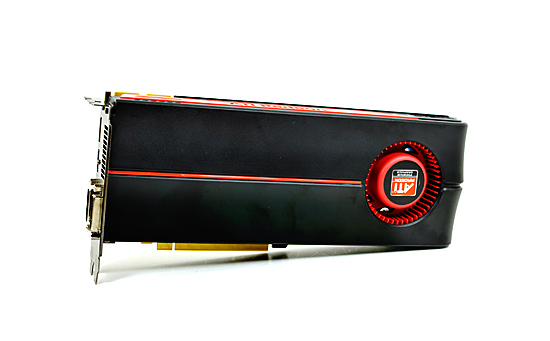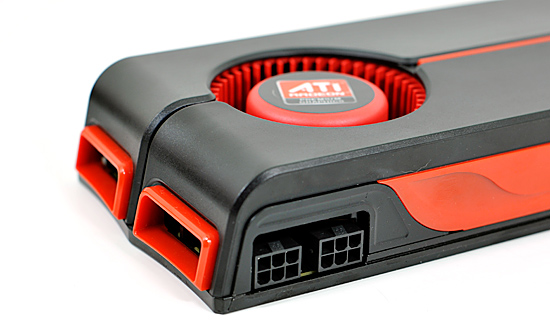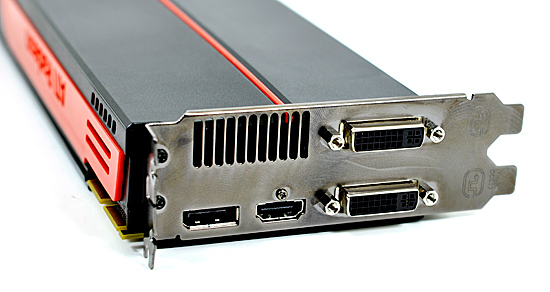AMD's Radeon HD 5870: Bringing About the Next Generation Of GPUs
by Ryan Smith on September 23, 2009 9:00 AM EST- Posted in
- GPUs
Meet the 5870
The card we’re looking at today is the Radeon HD 5870, based on the Cypress core.

Compared to the Radeon HD 4870, the 5870 has seen some changes to the board design. AMD has now moved to using a full sheath on their cards (including a backplate), very much like the ones that NVIDIA has been using since the 9800GTX. The card measures 10.5” long, an inch longer than the 4890 or the same as the 4870x2 and the NVIDIA GTX lineup.
The change in length means that AMD has moved the PCIe power connectors to the top of the card facing upwards, as there’s no longer enough room in the rear. Facing upwards is also a change from the 4870x2, which had them facing the front of the card. This, in our opinion, makes it easier to plug and unplug the PCIe power connectors, since it’s now possible to see what you’re doing.
Since the card has a TDP of 188W, AMD can still get away with using two 6-pin connectors. This is going to be good news for those of you with older power supplies that don’t feature 8-pin connectors, as previously the fastest cards without 8-pin connectors were the 4890 and GTX 285.

Briefly, the 5850 that we are not testing today will be slightly smaller than the 5870, coming in at 9.5”. It keeps the same cooler design, however the PCIe power connectors are back on the rear of the card.
With the 5800 series, DisplayPort is getting a much-needed kick in the pants. DisplayPort (full size) is standard on all 5800 series cards – prior to this it has been rather absent on reference cards. Along with a DisplayPort, the 5870 reference card contains a dedicated HDMI port, and a pair of DVI ports.
Making 4 ports fit on a card isn’t a trivial task, and AMD has taken an interesting direction in making it happen. Rather than putting every port on the same slot of the bracket as the card itself, one of the DVI ports is raised on to the other bracket. ATI could have just as easily only equipped these cards with 1 DVI port, and used an HDMI-to-DVI adapter for the second port. The advantage of going this direction is that the 5800 series can still drive two VGA monitors when using DVI-to-VGA adapters, and at the same time having an HDMI port built in means that no special adapters are necessary to get an HDMI port with audio capabilities. The only catch to this specific port layout is that the card still only has enough TMDS transmitters for two ports. So you can use 2x DVI or 1x DVI + HDMI, but not 2x DVI + HDMI. For 3 DVI-derived ports, you will need an active DisplayPort-to-DVI adapter.
With the configuration AMD is using, fitting that second DVI port also means that the exhaust vent of the 5800 series cards is not the full length of the card as is usually common, rather it’s a hair over half the length. The smaller size had us concerned about the 5870’s cooling capabilities, but as you’ll see with our temperature data, even with the smaller exhaust vent the load temperatures are no different than the 4870 or 4850, at 89C. And this is in spite of the fact that the 5870 is rated 28W more than the 4870.

With all of these changes also comes some changes to the loudness of the 5870 as compared to the 4870. The 27W idle power load means that AMD can reduce the speed of the fan some, and they say that the fan they’re using now is less noticeable (but not necessarily quieter) than what was on the 4870. In our objective testing the 5870 was no quieter than any of the 4800 series cards when it comes to idling at 46.6dB, and indeed it’s louder than any of those cards at 64dB at load. But in our subjective testing it has less of a whine. If you go by the objective data, this is a push at idle and louder at load.
Speaking of whining, we’re glad to report that the samples we received do not have the characteristic VRM whine/singing that has plagued many last-generation video cards. Most of our GTX cards and roughly half of our 4800 series cards generated this noise under certain circumstances, but the 5870 does not.
Finally, let’s talk about memory. Despite of doubling just about everything compared to RV770, Cypress and the 5800 series cards did not double their memory bandwidth. Moving from the 4870 and it’s 900MHz base memory clock, the 5870 only jumps up by 33% to 1.2Ghz, in effect increasing the ratio of GPU compute elements to memory bandwidth.
When looking back at the RV770, AMD believes that they were not bandwidth starved on the cards that used GDDR5. And since they had more bandwidth than they needed, it was not necessary to go for significantly more bandwidth for Cypress. This isn’t something we can easily test, but in our benchmarks the 5870 never doubles the performance of the 4870, in spite of being nearly twice the card. Graphics processing is embarrassingly parallel, but that doesn’t mean it perfectly scales. The different may be a product of that or a product of the lack of scaling in memory bandwidth, we can’t tell. What’s for certain however is that we don’t have any hard-capped memory bandwidth limited situations, the 5870 always outscores the 4870 by a great deal more than 33%.










327 Comments
View All Comments
avaughan - Wednesday, September 23, 2009 - link
Ryan,When you review the 5850 can you please specify memory size for all the comparison cards. At a guess the GTS 250 had 1GB and the 9800GT had 512 ?
Thanks
ThePooBurner - Wednesday, September 23, 2009 - link
With a full double the power and transistors and everything else including optimizations that should get more band for buck out of each one of those, why are we not seeing a full double the performance in games compared to the previous generation of cards?SiliconDoc - Wednesday, September 23, 2009 - link
Umm, because if you actually look at the charts, it's not "double everything".In fact, it's not double THE MOST IMPORTANT THING, bandwidth.
For pete sakes an OC'ed GTX260 core 192 get's to 154+ bandwidth rather easily, surpassing the 153.6 of ati's latest and greatest.
So, you have barely increased ram speed, same bus width... and the transistors on die are used up in "SHADERS" and ROPS....etc.
Where is all that extra shader processing going to go ?
Well, it goes to SSAA useage for instance, which provides ZERO visual quality improvement.
So, it goes to "cranking up the eye candy settings" at "not a very big framerate improvement".
--
So they just have to have a 384 or a 512 bus they are holding back. I dearly hope so.
They've already been losing a BILLION a year for 3+ years in a row, so the cost excuse is VERY VERY LAME.
I mean go check out the nvidia leaked stats, they've been all over for months - DDR5 and a 512 bit, with Multiple IMD, instead of the 5870 Single IMD.
If you want DOUBLE the performance wait for Nvidia. From DDR3 to DDR5, like going from 4850 to 4890, AND they (NVIDIA) have a whole new multiple instruction super whomp coming down the pike that is never done before, on their hated "gigantic brute force cores" (even bigger in the 40nm shrink -lol) that generally run 24C to 15C cooler than ati's electromigration heat generators.
---
So I mean add it up. Moving to DDR5, moving to multiple data, moving to 40nm, moving with 512 bit bus and AWESOME bandwidth, and the core is even bigger than the hated monster GT200. LOL
We're talking EPIC palmface.
--
In closing, buh bye ati !
silverblue - Thursday, September 24, 2009 - link
Let's wait for GT300 before we make any sweeping generalisations. The proof is in the pudding and it won't be long before we see it.And don't let the door hit you on the way out.
SiliconDoc - Thursday, September 24, 2009 - link
Oh mister, if we're waiting, that means NO BUYING the 5870, WAIT instead.Oh, yeah, no worries, it's not available.
---
Now, when my statements prove to be true, and your little crybaby snark with NO FACTS used for rebuttal are proven to be wasted stupidity, WILL YOU LEAVE AS YOU STATED YOU WANT ME TO ?
That's what I want to know. I want to know if your little wish applies to YOU.
Come on, I'll even accept a challenge on it. If I turn out to be wrong, I leave, if not you're gone.
If I'm correct, anyone waiting because of what I've pointed out, has been given an immense helping hand.
Which BY THE WAY, the entire article FAILED TO POINT OUT, because the red love goes so deep here.
-
But, you, the little red rooster ati fanner, wants me out.
ROFL - you people are JUST INCREDIBLE, it is absolutely incredible the crap you pull.
NOW, LET US KNOW WHAT LEAKED NVIDIA STATS I GOT INCORRECT WON'T YOU!?
No of course you won't !
silverblue - Friday, September 25, 2009 - link
Another problem I have with people like you is the unerring desire to rant and rave without reading things through. I said wait for GT300 before doing a proper comparison. Have you already forgotten the mess that was NV30? Paper specs do not necessarily equal reality. When the GT300 is properly previewed, even with an NDA in place, we can all judge for ourselves. People have a choice to buy what they like regardless of what you or I say.I'm not an ATI fanboy. I expended plenty of thought on what parts to get when I upgraded a few months back and that didn't just include CPU but motherboard and graphics. I was very close to getting a higher end Core2 Duo along with an nVidia graphics card; at the very least I considered an nVidia graphics card even when I decided on an AMD CPU and motherboard. In the end I felt I was getting better value by choosing an ATI solution. Doesn't make me a fanboy just because my money didn't end up on the nVidia balance sheet.
I'll take back the little comment about letting the door hit you on the way out. It wasn't designed to tell you to go away and not come back again, so my bad. I was annoyed at your ability to just attack a specific brand without any apparent form of objectivity. If you hate ATI, then you hate ATI, but do we really need to hear it all the time?
If the information you've posted about the GT300 is indeed accurate and comparable to what we've been told about the 58x0 series, then that's great, but you're going to need to lay it out in a more structured format so people can digest it more readily, as well as lay off the constant anti-ATI stance because appearing biased is not going to make people more receptive to your viewpoint. I remain sceptical that your leaked specs will end up being correct but in the end, GT300 is on its way and it'll be a monster regardless of whatever information you've posted here. I'm not going to pretend I know anything technical about GT300, but you must realise that what you've essentially done in this article is slate a working, existing product line that is being distributed to vendors as we speak in a manner that's much slower than ATI had intended yet you're attacking people for being interested in it over the GT300 which hasn't been reviewed yet, partly because you think the product is vapourware (which isn't really the case as people are getting hold of the 5870 but at a lower rate than ATI would like). Some people will choose to wait, some people will jump on the 58x0 bandwagon right now, but it's not for you to decide for them what they should buy.
Now relax, you're going to have a heart attack.
SiliconDoc - Wednesday, September 30, 2009 - link
What a LOAD OF CRAP.I don't have to outline anything, remember, ALL YOU PEOPLE cARE ABOUT IS GAMING FRAMERATE.
And that at "your price point" that doesn't include "the NVIDIA BALANCE SHEET". - which io of course, the STRANGEST WAY for a reddie to put it.
YOU JUST WANT ME TO SHUT UP. YOU DON'T WANT IT SAID. WE'LL I'M SAYING IT AGAIN, AND YOU FAILED TO ACCEPT MY CHALLENGE BECAUSE YOU'RE A CHICKEN, AND CENSOR !
---
Oh, do we have to hear it... blah blah blah blah...
--
YES SINCE THIS VERY ARTICEL WAS ABSOLUTELY IRRESPONSIBLE IN NOT PROPERLY ASSESSING THE COMPETITION.
CarrellK - Wednesday, September 23, 2009 - link
If a game ran almost entirely on the GPU, the scaling would be more of what you expect. You can put in a new GPU, but the CPU is no faster, main memory is no faster of bigger, the hard disk is no faster, PCIE is no faster, etc.The game code itself also limits scaling. For example the texture size can exceed the card's memory footprint, which results in performance sapping texture swaps. Each game introduces different bottlenecks (we can't solve them all).
We do our best to get linear scaling, but the fact is that we address less than a third of the game ecosystem. That we do better than 33% out of a possible 100% improvement is I think a testimony to our engineers.
BlackbirdCaD - Wednesday, September 23, 2009 - link
Why no load temp of 5870 in Crossfire??Load temp is much more important than idle temp.
There is lots of uninteresting stuff like soundlevel at idle with 5870 in crossfire, but the MOST IMPORTANT is missing: load temp with 5870 in crossfire.
SiliconDoc - Wednesday, September 23, 2009 - link
I just pulled up the chart on the 4870 CF, and although the 4870x2 was low 400's on load system power useage, the 4870 CF was 722 watts !So, I think your question may have some validity. I do believe the cards get a bit hotter in CF, and then you have the extra items on the PCB, the second slot used, the extra ram via the full amount on each card - all that adds up to more power useage, more heat in the case, and higher temps communicating with eachother. (resends for data on bus puases waitings, etc. ).
So there is something to your question.
---
Other than all that the basic answer is "red fan review site".
The ATI cards are HOTTER than the nvidia under load as a very, very wide general statement, that covers almost every card they both make, with FEW exceptions.